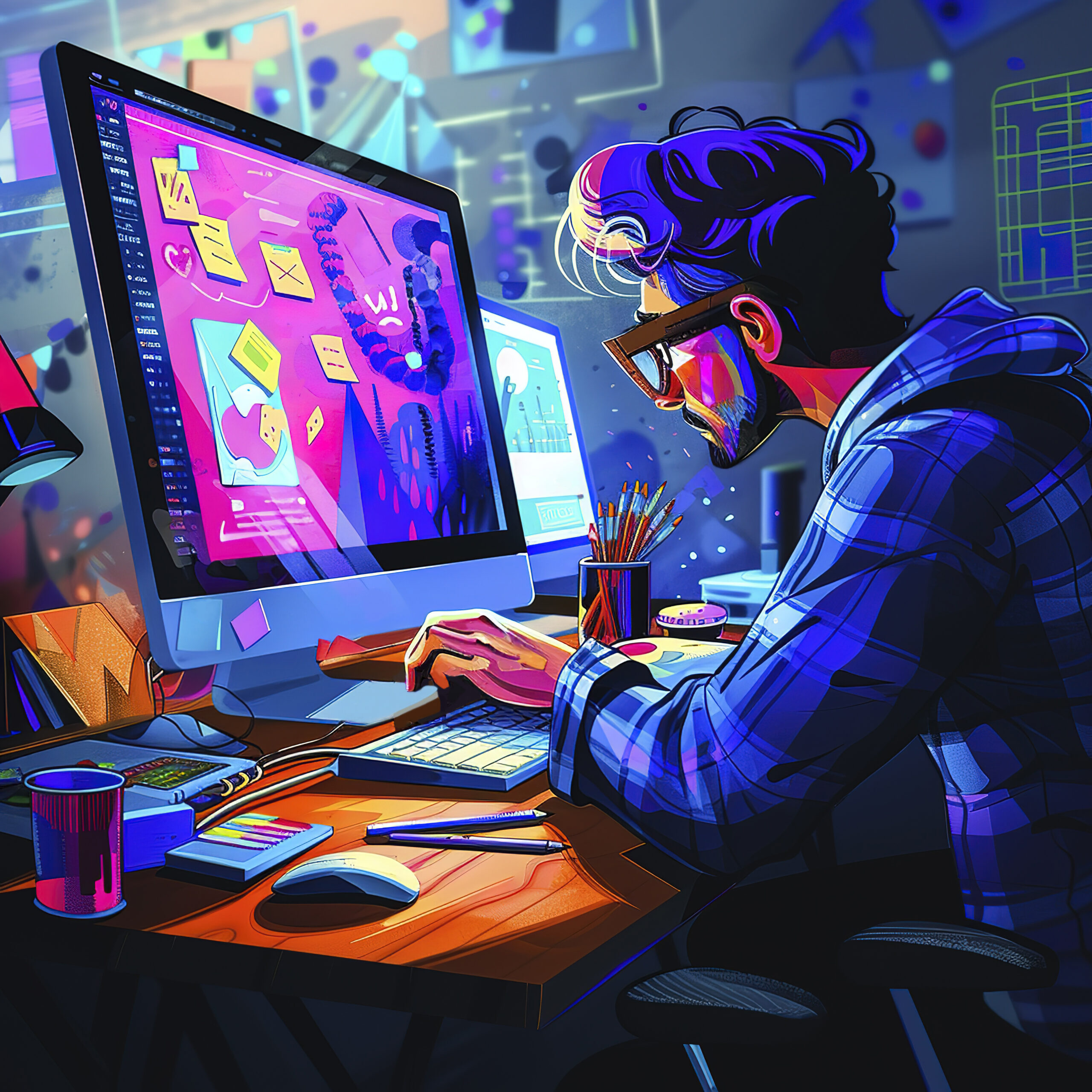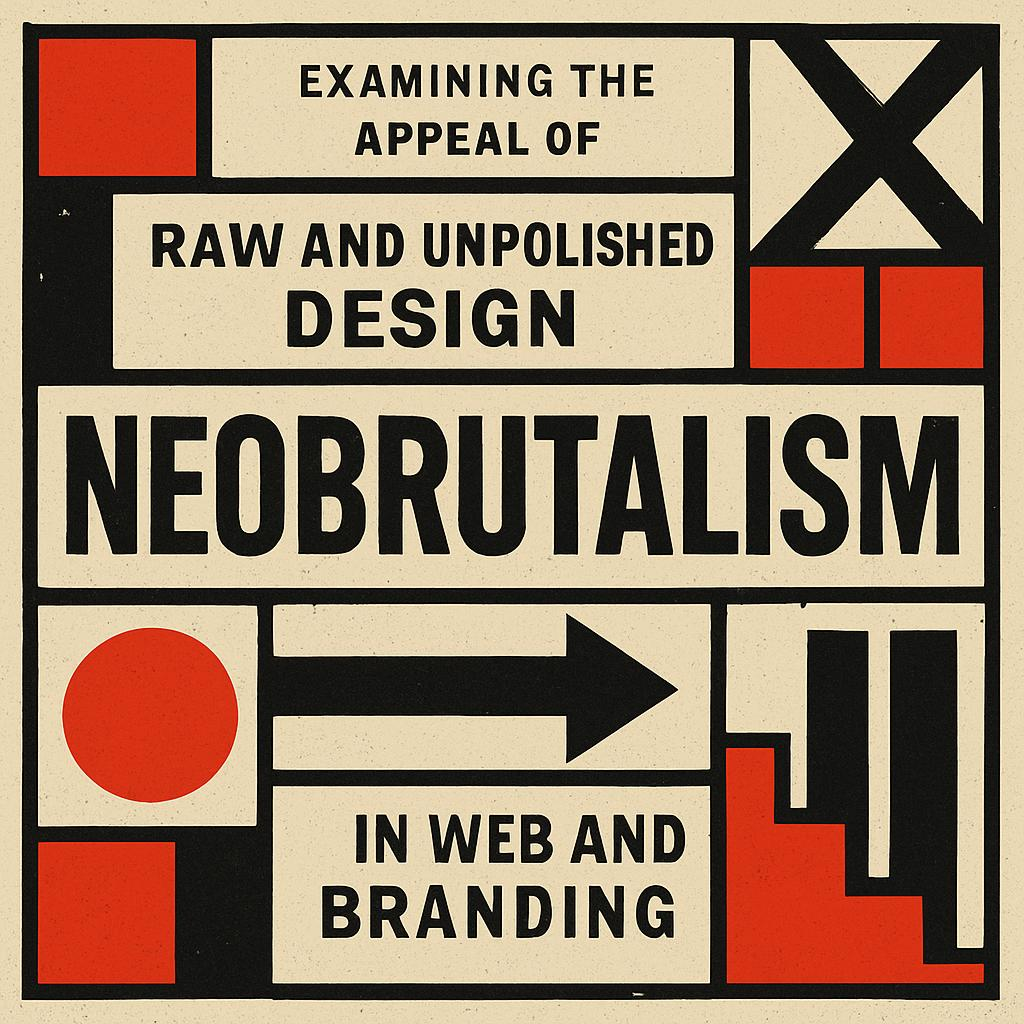The Concrete Jungle of Design: What's the Neobrutalism Buzz About? In a digital landscape often dominated by smooth gradients, playful animat
The Concrete Jungle of Design: What’s the Neobrutalism Buzz About?
In a digital landscape often dominated by smooth gradients, playful animations, and meticulously crafted interfaces, Neobrutalism in web design and branding crashes onto the scene like a rogue wave of industrial chic. But what exactly is this stark and seemingly abrasive aesthetic that’s got designers both intrigued and, let’s be honest, a little perplexed?
Think of it as the design world’s rebellious teenager, pushing back against the overly polished perfection that has become the norm. At its core, neobrutalism draws inspiration from the Brutalist architectural movement of the mid-20th century. Remember those massive concrete structures – often imposing, functional, and devoid of unnecessary ornamentation? Yeah, we’re channeling that energy into our websites and brand identities.
Imagine websites with stark, unadorned typography, often in a system default font. Picture bold, contrasting color palettes that aren’t afraid to clash. Envision layouts that prioritize function over flawless form, sometimes even showcasing the underlying grid or structural elements. This isn’t about pixel-perfect finesse; it’s about raw honesty and a deliberate embrace of the “imperfect.”
Stripping Back the Layers: Key Characteristics of Stark and Raw Website Designs
So, what are the tell-tale signs you’ve stumbled into the neobrutalism zone? Let’s break down some of the key characteristics that define this intriguing style:
Unapologetic Typography: Forget elegant serifs and perfectly kerned fonts. Neobrutalism often favors bold, sans-serif typefaces, sometimes even the operating system’s default font, presented in large, impactful sizes. It’s about legibility and directness, not necessarily beauty in the traditional sense. Think of it as the design equivalent of shouting the headline from a concrete rooftop.
Honest Color Palettes: While not exclusively monochromatic, neobrutalism often employs high-contrast color schemes. Think stark black and white, bold primary colors, or even muted, industrial tones. Gradients and subtle color transitions? Not invited to this party. The focus is on clear visual hierarchy and impactful statements.
Raw and Functional Layouts: Forget intricate, flowing designs. Neobrutalist layouts often embrace a grid-based structure, sometimes even making the grid lines visible. Elements are placed with a focus on functionality and hierarchy, often with generous whitespace that emphasizes the individual components. It’s like showing the scaffolding of your design, saying, “Here’s how it works, no frills.”
Minimal or No Decoration: This is where the “brutal” part truly shines. Forget drop shadows, rounded corners, and elaborate illustrations. Neobrutalism strips away the superfluous, leaving behind the bare essentials. Buttons might be simple rectangles with sharp corners, images might be presented without frames, and ornamentation is generally frowned upon.
Embracing Imperfection: This is a crucial aspect. Unlike the pursuit of flawless digital perfection, neobrutalism can sometimes incorporate elements that might be considered “flaws” in traditional design – visible grid lines, slightly misaligned elements, or a general sense of unpolished rawness. This intentional imperfection adds to the unique character and rebellious spirit of the style.

Why the Appeal? Decoding the Allure of the Unrefined in Digital Design
So, why are designers and brands gravitating towards this seemingly abrasive aesthetic? In a world saturated with similar-looking sleek and polished designs, neobrutalism offers a breath of fresh, albeit somewhat industrial, air. Here are a few reasons for its growing appeal:
Standing Out from the Crowd: In a sea of sameness, stark and raw website designs are undeniably attention-grabbing. Their unconventional nature makes them instantly memorable, which can be a huge advantage for startups and indie brands looking to make a statement. Imagine a new tech company with a website that looks like it was built in a digital bunker – it’s certainly going to spark curiosity!
Projecting Authenticity and Honesty: The unpolished nature of neobrutalism can convey a sense of honesty and authenticity. By stripping away the visual fluff, brands can project an image of being direct, transparent, and focused on substance over superficiality. This can resonate particularly well with audiences who are wary of overly corporate or inauthentic messaging.
A Nod to Retro and Counter-Culture: There’s a certain retro charm to neobrutalism, echoing the design sensibilities of a bygone era. It can also tap into a counter-cultural spirit, appealing to those who feel alienated by mainstream aesthetics. It’s the design equivalent of listening to vinyl records in a digital age.
Emphasis on Functionality and Content: By minimizing visual distractions, neobrutalism can put a stronger emphasis on the core functionality and content of a website or brand identity. This can be particularly beneficial for information-heavy websites or brands that prioritize clear communication. Think of a scientific journal website that prioritizes readability and data presentation over elaborate visuals.
Navigating the Concrete Jungle: Considerations for Implementing Neobrutalism
While the raw and rebellious nature of neobrutalism can be appealing, it’s not a one-size-fits-all solution. Here are a few crucial considerations for web designers and branding agencies thinking of embracing this aesthetic:
User Experience is Still King (or Queen): While neobrutalism can push boundaries, it shouldn’t come at the expense of usability. Navigation should still be clear, content should be readable, and the overall user experience should remain intuitive. Just because it looks like a concrete block doesn’t mean it should function like one.
Accessibility Matters: High-contrast color palettes are often a feature of neobrutalism, which can be beneficial for accessibility. However, designers need to be mindful of colorblindness and ensure sufficient contrast ratios. Similarly, the bold typography should still be legible for all users.
Brand Alignment is Key: Neobrutalism has a strong visual identity. It’s crucial to consider whether this stark and industrial aesthetic aligns with the brand’s personality and target audience. A playful children’s brand might not find its perfect match in the concrete jungle of neobrutalism.
Subtlety Can Be Powerful: You don’t have to go full-throttle brutalist. Incorporating subtle elements of the style, such as bold typography or a stripped-back layout, can be an effective way to inject some edge without alienating users. Think of it as adding a touch of industrial grit to an otherwise clean design.
The Unpolished Future: Will Neobrutalism Stick Around?
Neobrutalism in web design and branding is undoubtedly a bold and distinctive trend. Whether it becomes a long-term staple or evolves into something new remains to be seen. However, its current popularity highlights a desire for authenticity, a willingness to challenge design conventions, and an appreciation for raw, unadorned aesthetics.
So, what’s your take? Are you ready to embrace the concrete jungle of design, or do you prefer the smoother landscapes? We’d love to hear your thoughts! Share your opinions and examples of stark and raw website designs in the comments below. Let’s continue the conversation and explore the fascinating world of the unpolished in digital design!



COMMENTS